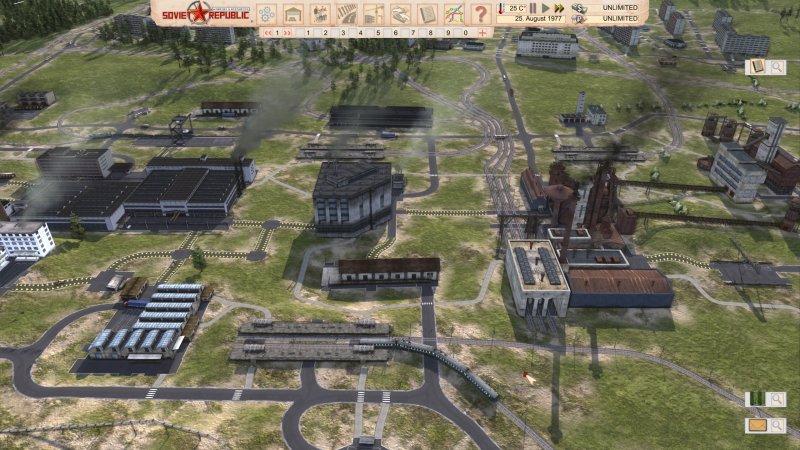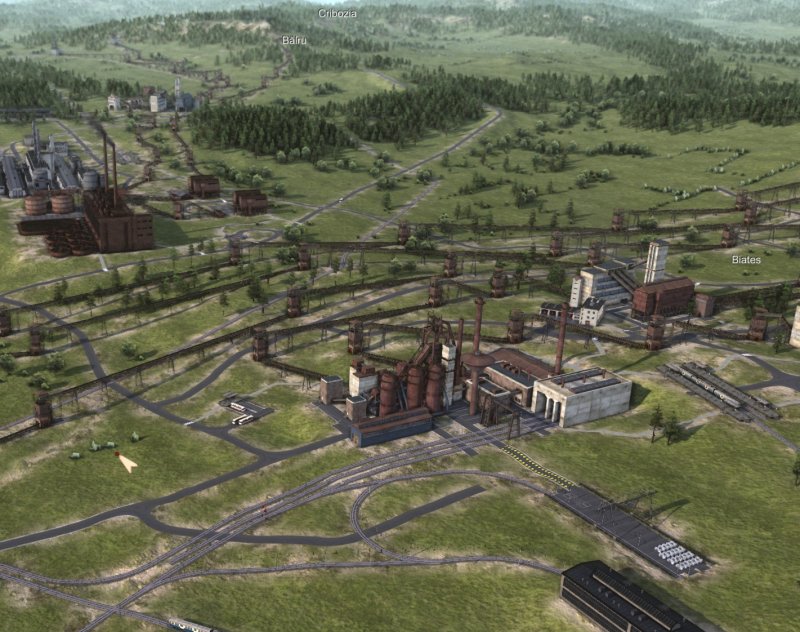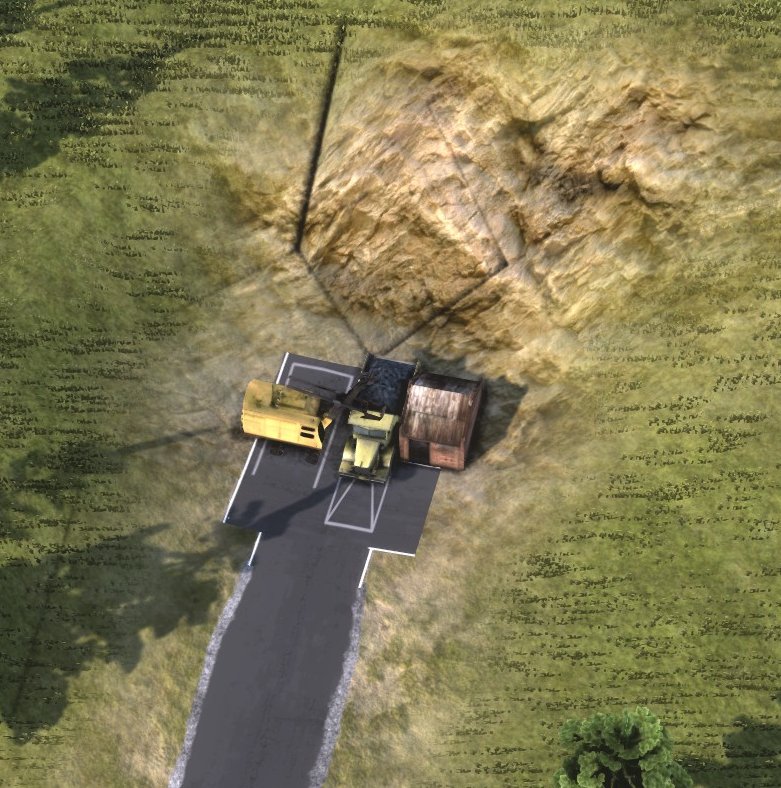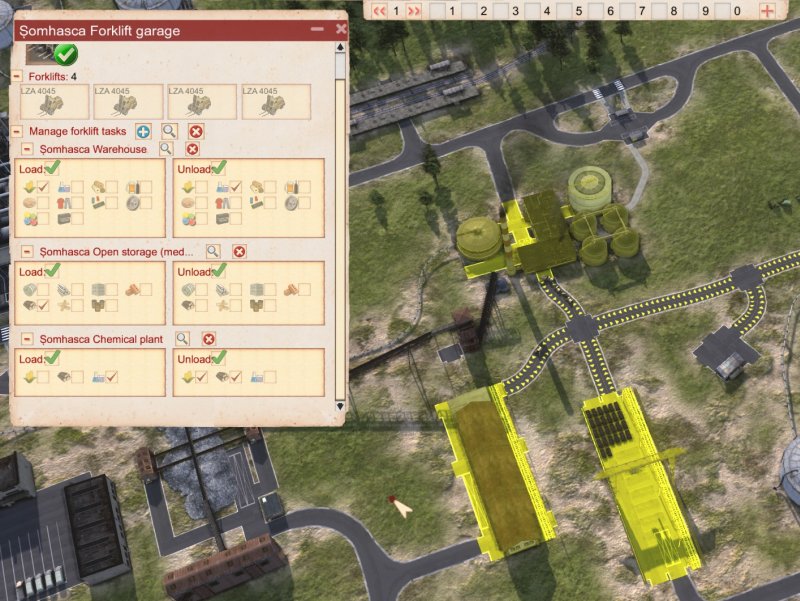Updated: March 17, 2021
As you know, comrades, I found myself a perfect new game - Workers & Resources: Soviet Republic. You know a game is good when it invades your dreams. That, or it means sensory overload. I find myself thinking about the game's industry planning facets all the time, and wait with great anticipation to when I can play again. Real-life tasks and duties occasionally interfere with my schedule, that is.
The one thing that Workers & Resources doesn't do well - it's to teach you how to actually go about its complex mechanisms, and how to build your industry well. I spent the first few hours really annoyed - luckily the fun factor outweighed the nonsense, but I can easily see players dropping out because they don't have the patience to persist with the awkward learning curve. Which is a total shame, as Soviet Republic is brilliant. So let's see if I can help. Here be a little guide to effective, profitable industry. A first of several guides, mind.

Protip: Start humble
So, don't go blazing hard mode right away. The game is too complex for that. You should learn the game's interface, building management and connections first before you hazard seasons, night & day cycle, pollution, and worst of all, power. The last is really gruesome - the combination of powering and heating buildings and providing fuel for your trucks and buses. Takes true dedication. Before you hazard this element of the game, I'd suggest learning how to manage the industry well, and only then try your luck with the energy sector.
Tip 1: Building placement
Workers & Resources: Soviet Republic has an annoying thing - you have a limited degree of freedom in how and where you place your buildings. You must rotate them just so, and then, the terrain must be flat. You can't just carve swaths out of mountains, which is rather unrealistic, but hey. This dictates how you go about designing your perfect industry zone.
- Industry management in the game is complex - it can take five or nine steps, ergo buildings, from raw resource to final product. You need a lot of space.
- You should start from the end - place the final building in the chain first, and then work your way back. This way, you won't suddenly discover you're missing a key building connection.

I think I've created a pretty efficient industry zone here - everything is easily accessible. I still have four double-line train stations, four bus stations (and about 40 buses) feeding workforce to the complex.
- Building connections - inputs and outputs - each factory requires certain inputs (raw materials), one or more. For instance, the steel mill needs coal, which is produced in coal manufacturing plants from coal ore hauled from coal mines, and iron, which is processed in iron forgers from ore hauled from ore mines. Thus, if you want to place a steel mill somewhere on the map, the inputs need to face toward the previous step in the manufacturing process (iron and coal plants). You can use the existing rail connections to import the raw material from afar (including across the border), if you don't want to overwhelm your local industry.
- Conveyor belt connections allow for unlimited distance, so you can place processing plants far from the raw sources. This helps overcome terrain limitations and helps concentrate complex industry.

The beautiful chaos, rusty conveyor belts. Looks quite messy, and it is - but only visually.
- Oil pipes have a limited maximum distance, so you need to place your refineries and/or other building that require oil relatively close by, or use pumps. Luckily, oil wells are located on the plains, not the hills, so you usually won't face any issue with terrain limitations.
Tip 2: Inputs and outputs
Now that I've mentioned those, let's expand a little. Apart from the "source" buildings, all other industry buildings will require inputs. The resources can be connected directly to the plant's input or they can be ferried in via truck or train. The first method is the most efficient, because it does not require any vehicle to ferry goods, hence less maintenance cost. The game achieve this via factory connections, and these must go directly from one building to another.
If you cannot connect two factories directly, you can still use factory connections via intermediate factory junctions. If you use them, you will need to connect a forklift garage, and then assign tasks to your vehicles, what to load at point A and what to unload at point B. There can be of course more than one task, and/or more than one resource material.

Multiple connections, forklifts. My electronics assembly hall is doing fine.
Tip 3: Input efficiency
Your factory throughput capacity will depend on two primary factors: 1) the availability of workers - you need lots of trains and buses to bring in workers to their workplace, all the time 2) the availability of input resources. The latter is far more critical than you imagine, for many reasons.
- Raw material source quality - say you have an ore mine with only 7% raw material quality. This means, under ideal circumstances, the building will only be able to produce 7% of its total daily capacity, and then send that quantity via conveyor belt to the relevant factory. If you have suboptimal raw material quality, you will need additional sources.
- If a building has more than one input (for instance, the steel mill has four), then this means you can connect multiple sources. Using steel mill as our demonstrator, this translates into two iron factories and two coal factories, or a different mix, based on the requirements and the overall throughput capacity of each source. If you do not use all of the input connections, you will most likely not hit the 100% total possible efficiency, even with the full roster of workers.
- Distance from source - in some cases, you will be able to provide materials directly, either via conveyor belt, pipe, or by connecting factories together, back to back, via factory connections. In some cases, this may not be possible. For example, you may need to send chemicals or fabrics from one part of the map to a destination half way across. In that case, you will need to use road and rail transport to deliver the materials to the relevant factory. If your vehicles need to travel a long distance, then your factories may be without the necessary goods for a while, which translates into 100% production line downtime. To that end, you should try to send goods a short distance, or if you cannot, procure sufficient quantities, so that they last long enough until the next trip. For example, I found out that my chemical plant couldn't produce enough chemicals for all the different industries (aluminum, nuclear fuel, plastics, etc), and I had to import from a customs warehouse.

You get a lovely 25t dumper in the 60s and 70s - then it's gone!
Tip 4: Storage facilities & distribution centers
The game developers figured that there could be material shortages, so they supplied you with a whole lot of storage buildings. More than any other urban simulator I can think of - you have warehouses, you have aggregate storage, you have open storage, oil and container loading facilities for rail and truck, and you also have distribution centers, which are like forklift garages, except they do all their running around on asphalt roads.
Placing storage close to factories is a good thing - especially if you can do this via a secondary factory connection. This means that produce will go into a large building that can store large amounts of the materials. For example, a medium open storage can hold more than 1,000 tons of metal. So if you need to supply raw materials to a factory, you can then put them on a train, and send them all in one go rather than pollute your road with fifty trucks.
More importantly, warehouses allow you to stockpile on goods so that you have reserves in between resupply trips. Say you need chemicals for your plastics factory. If your chemical plant can't provide enough, you will have a downtime - but if you import extra chemicals from a border customs house (at a price, but still), then you will have a reserve you can use while you wait for the chemical plant to churn out a fresh batch.

Distribution centers and forklift garages can handle multiple tasks.
Here, you also need a transport hub to manage the proper and timely resupply of all your buildings. You can do this manually - create a vehicle that will do one specific task between two buildings, or you can use distribution centers, which can be tasked with multiple cargo assignments between multiple buildings, using a common (and hopefully cheaper) fleet of vehicles. Here, you will have the option to set the lowest limit of supply at destination - if the quantity goes below that, your vehicles will go out for more goods. Thus, the higher the limit, the busier your vehicles will be. But then, you will also need more vehicles to make sure all the tasks can be accompanied in parallel.
The beauty of the distribution centers is that they allow you to have 10-20 tasks assigned to some 5-8 vehicles of different kinds, without having to worry what each truck does individually. Your center will take care of the distribution, e.g. load chemicals at the plant, unload at the warehouse A, load crops at the silo, unload at the warehouse B, load plastic at the factory, unload at the warehouse A, load both plastic and chemicals at the warehouse A and dispatch to the car manufacturing plant. Just a wild example.
Tip 5: Transport
I found out that not all commodities are listed, so you may wonder how to ship them. The answer is, don't worry about it. Simply send a truck or a train to the relevant factory (or factory connection), and the goods will be loaded. You can use flatbeds to transport most final products, including locomotives and tractors, cars, nuclear fuel, and such.
Trains are good for things shipped in large quantities, otherwise, they are very expensive and take a long time to justify the price tag. Furthermore, the signaling system in the game is very cumbersome - reminds me of OpenTTD - so you're best doing a one rail = one train setup until you have the time and convenience to figure the signals. This goes into the same bucket as the energy sector.
Tip 6: Profitability
In the end, you can do this for fun. Or you can try to have a profitable business. This is quite tricky to do, because there are many variations in the equation. Excluding the initial/upfront cost of setting up a factory, your main considerations will be whether to produce everything locally, or to import raw materials from abroad and then export only the final (and expensive goods)?
I still don't have a definite answer to this. Grand example: nuclear fuel.
In the game, you can set up your own nuclear fuel plant - with the ultimate goal of providing this fuel to your own nuclear reactors, which can then export electricity at a premium to both the Soviet partners and Western countries. However, you can also play without having to worry about power - in which case, you can export 100% of your fuel. It's the most expensive commodity, too - with a hefty price of about 55K dollars (or rubles) per ton (and rising). All right, so how do you go about this?
Let's say you want to do it all on your own. In my city Exhibit A, I've got two Uranium mines, which send the ore via long conveyor belts to two Uranium processing plants, which send Uranium Dioxide to a Uranium conversion plant. The last also needs chemicals to produce UF6, which is then sealed into protected casks, or shipped directly to the nuclear fuel fabrication plant, which also needs its own supply of chemicals to produce the expensive and lucrative nuclear fuel. Each of these buildings requires power plus workforce, which means several bus stations and a steady stream of buses ferrying people to and fro. This is a decent setup, and I've got a couple of flatbed trucks shipping the fuel to the customs house at the border, turning a neat little profit.

A semi leaving the nuclear plant with two casks - 0.5t of fuel - that's 27K dollars right there.
But ... I've not calculated how much money I'm wasting on the first three stages in the fuel fabrication process. In other words, if I subtract the cost and upkeep of these buildings, the maintenance - snowplows and firetrucks, the transportation of workers (10s of buses and stations), perhaps it's cheaper to import the raw materials directly to just the last building in the chain? Could I setup a small fleet or trucks - or maybe one long train - to get me just chemicals and UF6 to the fabrication plant? Would this be more effective than what I've made myself?
I have no answer just yet (hint, teaser for upcoming sequels), and I'm not sure if the game provides the necessary granularity of data to figure it out. But this is something I intend to explore in depth.
Then, there's the practical matter of location. In my example, the placement of different buildings is dictated by the availability of natural resources. This constraint means my fabrication plant is somewhat distant from the border, so the trips take time. However, if I were to important materials, I could plop the fabrication plant very close to the customs house, and then, I'd get the raw materials quickly, and also be able to send the produce back almost instantly. This means I'd save on fuel, time and the number of vehicles required - to get chemicals from the border to my plant, as I currently need 3-4 trucks. But if my factory was just next to the customs house, I may only need one.
Again, I don't have an instant answer - but this is something worth exploring in detail. And I will!
However, I did come up with some rather clear answers:
- Exporting cheap stuff (like wood boards or prefab concrete) is not useful. Stick with the expensive goods.
- I am making decent profit selling oil (fuel and bitumen), nuclear fuel and cars - at the moment, VW Beetle and several trucks. Cars go West, trucks to East. West side, East side. Innit.



- Crops are hard to come by unless you have lots of farms and silos, otherwise, they run out in winter months - best import large quantities and cheaply.
- Chemicals are also tricky - you will most likely need more than one plant to keep the supply for all the different industries, so you might as well produce some and import some.
- Steel and aluminum are good for export early on, but once you setup complex manufacturing, you will need them as raw resources for cars and trains, and this is where the real profit is.
- Construction office - ideally, you can do your own construction, but this requires a complex network of factories, trucks, cranes, bulldozers, pavers, rollers, and more. You might as well import all construction labor and materials, and offset the cost with premium exports.


It takes a lot of micro-management sorting the construction of new buildings.
Does it work?
Well, it does. I am slowly, steadily increasing my profits. They don't offset the huge building costs at this point, but then, I'm still expanding my industries, so the cost is expected. However, in terms of the actual day-to-day management, I'm already quite profitable. And I'm learning new tricks how to become even more efficient and save cost. This means placement, distance, what to import, when to use trains, and the best choice of trucks - hint, bigger isn't always better. You want the sweet spot between speed and haul capacity. Most importantly, I am having immense fun. And that's ALL that matters!

Conclusion
There you go. Don't treat this guide as the Holy Grail of Socialist Industry. Much like my traffic guides in Cities Skylines, the Good, the Better and the Best, these are my attempts to solve complex issues without losing the fun element, while still tycooning with style. If I were to focus on every single ruble or kW of energy, then the game would lose its charm, and I'd become a boring administrator. We don't want that.
Now, that said, I do intend to do more experimentation. As I said, I'm learning new tricks all the time, which kind of forces me to start over now and then, but hey, I remember this happening with Transport Tycoon Deluxe, with SimCity, with Cities Skylines, over and over. Part of the magic that is urban simulation and the almost impossible task of nailing perfection. I will definitely write a whole bunch of sequels, as I want to show you new, optimized industry layouts, touch on the air and ship transport, and finally, tackle the dreadful question of power and heating and fuel. Take care, fellow proletariat!
Cheers.